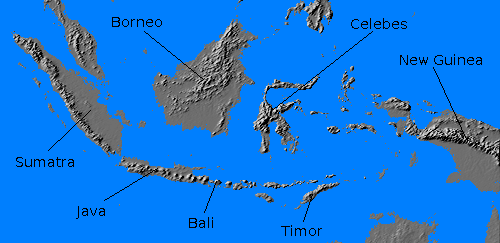The Pacific War Online Encyclopedia: Netherlands East Indies (original) (raw)
| ![]() The Pacific War Online Encyclopedia | |
| -------------------------------------------------------------------------------- | |
The Pacific War Online Encyclopedia | |
| -------------------------------------------------------------------------------- | |

The Netherlands East Indies, today known as Indonesia, consist of some 13,667 islands and islets stretching over 3000 miles (5000 km) from Sabangin the west to portions of New Guinea in the east. Most of the islands, except Borneo, are part of an island arc, with volcanic mountain chains running east to west and reaching to over 12,000' (3600 meters). There is more volcanic activity here than in any other region on Earth, with about 400 volcanic peaks of which over 100 are active. However, under the volcanoes lies a basement complex of sedimentary rock that included numerous oil fields. Conquest of the oil fields of the Netherlands East Indies was the initial Japanesewar objective.
The area was inhabited by early humans half a million years ago and had been settled by Indiansby the 7th century. By the 11thcentury Islam had been introduced in the west, and it gradually spread throughout the area over the next 600 years. ThePortuguese were the first Europeans to explore this area, but the Dutch established a post at Batavia in 1619 under the auspices of the United East India Company (Vereenigde Ooslindische Compagnie) and gradually absorbed the native kingdoms. The VOC governed brutally and shortsightedly but was abolished in 1798, the islands coming under direct control of the Dutch government. Dutch rule remained heavy handed until the Diponegoro uprising of 1825-1830, after which a more humane approach was attempted. Slavery was abolished and the infrastructure improved, and strict rules on land ownership kept most of the land in the hand of Indonesians. However, for the most part, Dutch administration from 1830 to 1940 went from brutal to ham-fisted.
By 1941 the island of Javawas virtually a second homeland to the Dutch people. Although Holland itself was overrun by the Germansin 1940, the Dutch government fled to Britain to continue the war. Much of the funding for the exiled government came from the oil fields of the Netherlands East Indies, but the Dutch military forces in the area were not strong, consisting of the equivalent of about three divisionsof indifferently trained infantry(mostly militia), perhaps 150 largely obsoleteaircraft, and naval forces whose largest units were light cruisers.
The population totaled over 70 million in 1941. This included 220,000 Dutch, of whom 80% were blijers born in the Netherlands East Indies and 20% were trekkers, administrators and businessmen on temporary assignment from Holland. The rest of the population was composed of 70,000,000 Indonesians, 1,300,000 Chinese, and 120,000 Arabs and other Asians, plus thousands of poorly counted primitive tribesmen in remote areas. The area produced large quantities of sugar, rubber, spices, quinine and other botanical drugs, timber, rice, copraand other vegetable products. More important to the Dutch were mineral products such as oil, tin, bauxite, manganese, nickel, copper,coal, goldand other precious metals and commodities. The Netherlands East Indies produced 90% of the world's quinine and 30 percent of its rubber.
Java had a good road and rail network, Sumatra rather less so, and the remainder of the islands had very little infrastructure outside of major cities. The road network totaled 43,450 miles (69,930 km) mostly on the two main islands. Coastal steamers were important. Railroads were limited to 4585 miles (7379 km), almost all on the two main islands. There were 1378 telegraph stations in the area and seventeen cities with populations in excess of 50,000 persons.
The Japanese coveted the resources of the Netherlands East Indies, and by 1940 were stockpiling considerable quantities of bauxite, scrap steel, rubber, nickel, and tin from the islands. Direct control of these and other resources was the principal objective of the Centrifugal Offensive with which Japan opened the war.
A strong nationalist movement was organized in 1927 under Sukarno and was active when the Japanese invaded in February of 1942.The Indonesian nationalist movement welcomed the Japaneseand their promise of independence. However, the Japanese slogan of “Asia for the Asians” rang hollow as the Netherlands East Indies were brutally exploited to support the Japanese war effort. Many of the Indonesian nationalists ended up fighting the Japanese, and even the“collaborationist”forces turned on the Japanese after the August 1945armistice. These same forces would resist the Dutch just as fiercely after they arrived to take over from the Japanese.
References
The Pacific War Online Encyclopedia © 2007-2008, 2010, 2012, 2014 by Kent G. Budge. Index
